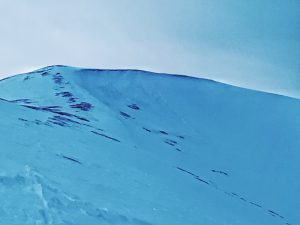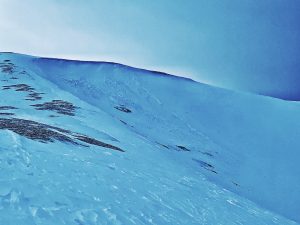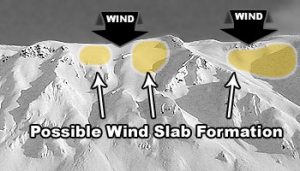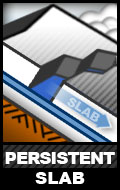Avalanche Danger Forecast
Issued Thursday, January 21, 2021 at 3pm for the greater Anchorage area Western Chugach Mountains (i.e. Chugach State Park). View map of primary forecast area here.
Avalanche danger is expected to fluctuate within the moderate spectrum through this forecast period. Expect danger to increase Saturday, and be at its peak for the forecast period later Saturday, due to the possibility of a few inches of new snow in the alpine (more so in eastern and southern areas) combined with moderate to strong winds capable of further wind loading leeward terrain.
It’s been an eventful week in the greater Anchorage area Western Chugach Mountains. The MLK holiday storm on Monday brought over an inch of SWE to mid elevation weather stations in both northern and southern zones of Chugach State Park. This equated to a widespread several inches of new snow, and over a foot in some upper elevation areas. Wind and precipitation from last weekend and Monday initiated a widespread natural avalanche cycle with many avalanches (to D2) observed across the park. These were somewhat obscured, having been partially filled in with more new snow later Monday.
Tuesday provided a brief window to enjoy the deep powder before winds increased Tuesday night into Wednesday. They’ve continued to blow steadily at moderate to strong speeds capable of redistributing Monday’s snowfall and loading leeward terrain since then. The moderate to strong winds late Tuesday night into Wednesday triggered widespread small (D1) natural wind slab avalanches on upper elevation leeward terrain, and changed surface conditions from perfect Western Chugach pow to variably wind-affected snow.
Of note, a skier triggered an avalanche, was caught, and carried on Peak 3 Tuesday. This skier chose to descend a line down the most heavily wind loaded feature on the commonly skied upper face. Multiple parties skied Peak 3 without incident both before and after this avalanche occurred by avoiding obviously wind loaded terrain features. This is a twofold important reminder:
- Peak 3 can and does produce avalanches (including deadly ones that have resulted in multiple fatalities).
- Learn and know how to identify heavily wind loaded terrain features; avoid them (especially within 24 hours of a significant storm).
While in the South Fork Eagle River area Tuesday we observed questionable decision making in regard to terrain selection, management, and safe travel protocols (especially within 24 hours of a significant storm). As with the Peak 3 incident, this decision making seemed encouraged by the party’s false sense of security due to prior tracks in the vicinity and further positive reinforcement due to having skied the line once without incident. This party descended, multiple times, a repeat offender avalanche path and terrain trap (that partially buried a skier and killed his dog in February of 2016) that is typically leeward and wind loaded. If you recreate in South Fork area avalanche terrain, we encourage you to check out this map with common paths and avalanche problem areas identified.
North Bowl avalanche that occurred late Tuesday or early Wednesday (this path is identified in our “South Fork Common Paths & Problem Areas Map“):
Active wind loading Wednesday:
Video regarding wind loading and wind slab development:
Avalanche Problems:
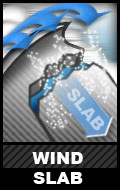 Wind slabs up to D2 in size are possible above 2500′ on leeward terrain steeper than 35º.
Wind slabs up to D2 in size are possible above 2500′ on leeward terrain steeper than 35º.
Moderate to strong winds have been blowing steadily since Tuesday night and are expected to continue. A few inches of new snow are possible on Saturday which, if it materializes, will provide even more loose snow for further wind loading of leeward terrain.
As the bulk of loose snow from Monday’s storm has already been redistributed from the past 48 hours of moderate to strong winds, a significant spike in wind slab danger will not occur unless and until more new snow materializes Saturday. If Saturday produces significant new snow, natural wind slabs will be possible through the weekend. Otherwise, expect steep leeward terrain to harbor stiff wind slabs that may be reactive to human triggers.
Active wind loading, recent natural avalanches, and shooting cracks are red flag indicators of wind slab danger. Hollow and/or punchy feeling snow (denser, wind-packed snow overlying looser and less cohesive snow) and pockets of deeper snow with a bulbous or fat appearance are further kinesthetic and visual indicators of potential wind slab danger.
Pole probing and hand pits are a quick and effective means of assessing this problem as you travel. Use pole probing to quickly feel out areas of denser, wind-packed snow overlying looser and weaker snow. Use hand pits to quickly assess how near-surface layers of snow are bonded.
Digging a snowpit and conducting a compression test and/or extended column test will provide an even better assessment of bonding and instability before you travel on terrain of consequence.
You can also assess wind slab instability via safer “test slopes” that are representative of higher consequence terrain.
Wind slabs are most likely to exist below corniced areas and along the lee sides of ridges and cross-loaded features like gullies:
Persistent slabs up to D2.5 in size are possible on all aspects above 2500′ where the terrain is steeper than 35º.
This is a low probability, but potentially high consequence, avalanche problem. While predominantly dormant, these persistent slabs are unpredictable and Monday’s significant snowfall and wind loading since then may make them more susceptible to human triggering.
Such hard slabs have a tendency to release above and around a human trigger, rather than at the trigger’s feet, which can make escape difficult. In addition, hard slab avalanche debris is more likely to cause trauma than debris from soft snow.
Diverse and widespread persistent weak layers exist in the snowpack. Faceted snow exists above and below crusts in some areas, sandwiched between wind packed layers in many areas, and a basal weak layer of advanced facets and depth hoar is widespread.
Be on the lookout for red flag warnings of persistent slab danger: recent natural avalanches, collapsing (aka “whumphing“), and shooting cracks. Understanding this avalanche problem where you intend to travel will require in-depth analysis: digging snowpits, conducting instability tests, and analyzing snowpack stratigraphy (layering).
Terrain management is simply the best way to avoid tricky avalanche problems: don’t expose yourself to terrain capable of producing a large and dangerous hard slab.
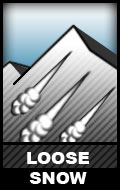 Dry, loose snow avalanches (aka “sluffs) are possible above 3000′ on steep (38º+) terrain. These will be limited to very isolated, wind-sheltered, upper elevation areas unless and until more new snow materializes Saturday. If we get the few inches of snow forecast for Saturday, expect both natural (wind-induced spindrift) and human triggered (sluffs) loose snow avalanches on steep, upper elevation terrain.
Dry, loose snow avalanches (aka “sluffs) are possible above 3000′ on steep (38º+) terrain. These will be limited to very isolated, wind-sheltered, upper elevation areas unless and until more new snow materializes Saturday. If we get the few inches of snow forecast for Saturday, expect both natural (wind-induced spindrift) and human triggered (sluffs) loose snow avalanches on steep, upper elevation terrain.
While these small avalanches (D1) aren’t much of a concern in regard to burial, they do have the potential to cause a fall or loss of control.
Don’t let a loose snow avalanche catch you off guard. Manage your sluff if descending steep terrain via ski or snowboard. Be mindful of heavy spindrift if climbing steep and/or exposed terrain.
Before traveling on or under terrain that has the potential to avalanche think about the consequences, and have a plan (to escape the avalanche, for re-grouping, and rescue).
Keep in mind that short days with a lot of darkness this time of year increase the difficulty of mountain travel and the consequences of an accident.
Click the hyperlinks and icons to learn more.


